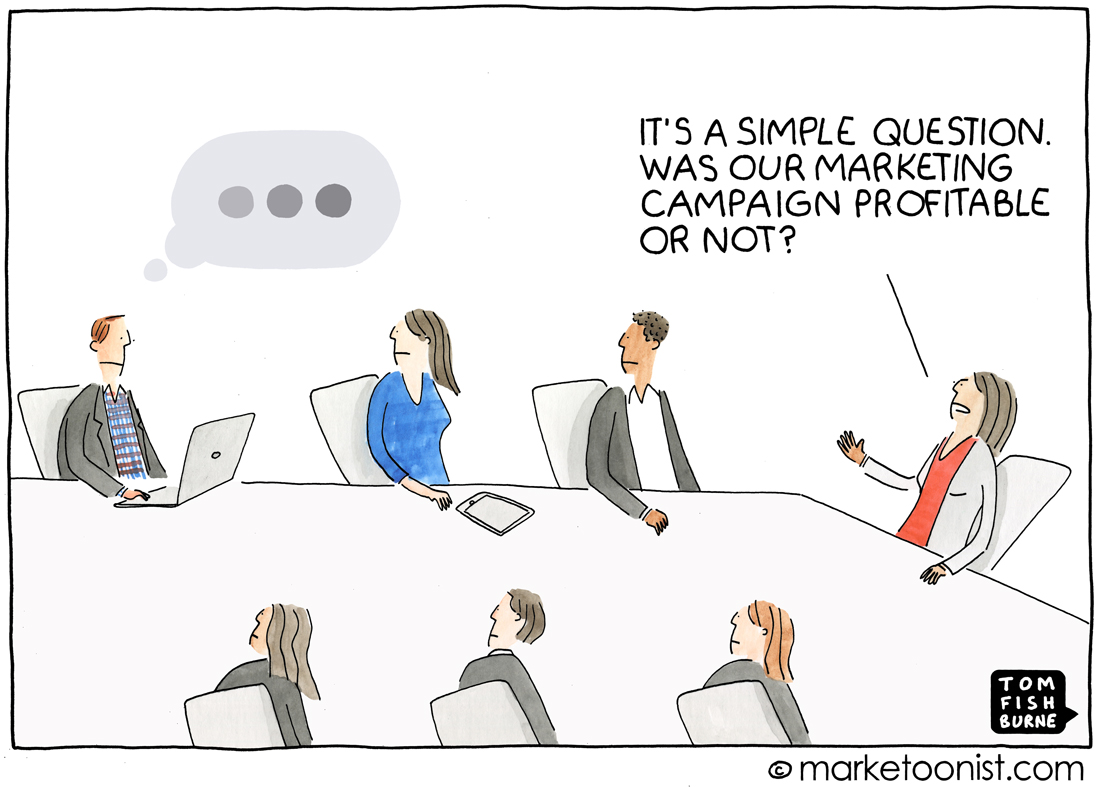Marketing Attribution: Tracking Touch Points Throughout the Customer Journey
Social shares and impressions may tell marketers more about the engagement and preferences of their target audience, but these vanity metrics don’t numerically prove the value of marketing efforts. Determining the efficacy of marketing efforts based on surface level metrics is like determining the health of a couple’s relationship based on their Instagram pictures. With the proliferation of channels and devices, marketing can be difficult to track and measure, but there is always more to the story.
Attribution fills in gaps in the story by assigning value to certain touch points during the consumer’s journey. Attributing value to each touch point helps marketers map out which marketing tactics are working during the buyer journey so that the marketer can adjust their strategies and better prove their worth to the C-Suite.
Cartoon created by Tom Fishburne
What is the goal of marketing attribution?
The ultimate goal of marketing attribution is to prove the efficacy of each marketing initiative and ultimately prove the return on marketing dollars spent. This is achieved by understanding the interactions across marketing channels throughout the funnel - what resonated with the audience and lead to their purchase?
By mapping out each interaction and pinpointing which touch points result in stronger consumer conversion, marketers can evaluate practices and optimize marketing expenditures accordingly. Because consumers respond differently to each conversion event, not every interaction has the same impact.
Attribution models vary - measuring the average number of touches, the length of engagement, and active channels. Each company should decide which model is best.
It is important that marketers get alignment throughout the process of setting up an attribution model. The entire team, including tech and finance, need to understand what is being measured and communicate the goals and key metrics. Goals can be set up in Google Analytics to help track success. Tweaks can be made to marketing materials such as ad copy, ads, ebooks, email, product images, or sign-up forms based on the analytics.
Different Types of Attribution Models to Consider:
First Touch Attribution
First Touch Attribution is measuring the first contact the consumer has with the brand. First Touch Attribution is beneficial for building brand awareness, evaluating direct responses, and generating leads. Though First Touch is not used in the business-to-business (B2B) world often, it is easy to set up and track top-of-the-funnel marketing campaigns. The downside of First Touch is that it does not measure all of the steps to conversion. Just like a first date doesn’t lead to marriage, an initial click doesn’t always result in a sale.
Last Touch Attribution
Last Touch Attribution measures the final engagement with the consumer before conversion (or a transaction). Last Touch is beneficial for direct response and conversion-focused campaigns. It is the most common, simple to set up, and easy to measure. The downside of Last Touch Attribution is that it neglects the prior touch points that lead to the ultimate click - the email campaigns, retargeting efforts, traditional media, or captivating content that possibly coerced the consumer to favor the brand along the journey. Last Touch’s neglect fails to measure the marketing’s true ROI, but it is beneficial, for example, to test landing pages. If certain landing page designs lead to more conversions, perhaps that ad copy or imagery is preferred by consumers and should be used in future campaigns.
Linear Attribution
Linear Attribution treats every touch point with same importance and weight. Though it is valuable to recognize all efforts, it is unrealistic that every interaction would have the same effect on consumers. Taking a spouse on an extravagant vacation versus buying an anniversary card will not result in the same level of happiness. Linear Attribution provides a generic overall picture that might highlight certain patterns.
Time Decay Attribution
Time Decay Attribution focuses on assigning greater value on the later stages of the funnel interactions rather than the early interactions further from the purchase. This model is best for longer sales cycles and timed promotional campaigns. The downside to Time Decay Attribution is that earlier interactions that may have been influential in the buyer’s journey are not acknowledged.
U-Shaped Attribution
U-Shaped Attribution places a higher value in the beginning and end touches within a campaign, but still acknowledges the interactions in the middle. Because the initial reaction and moment of conversion/purchase are more important, the first and last touch are weighted at 40% each and every interaction in the middle is weighted for a total of 20%. This model is not good for nurturing leads and it is debatable whether or not the first touch should be weighted equally with those close to conversion.
W-Shaped Attribution
W-Shaped Attribution assigns the same amount of credit to the first and last touch in addition to the moment the prospect switches to a lead. “The three touch points receive 30% credit each, and the last 10% is split across the others.” Every interaction (big and small) is still acknowledged with a higher emphasis on key conversions. This attribution model is similar to the U-Shaped model in that it gives each touch credit and applies to longer sales cycles. If there are multiple lead conversion touch points during the campaign, the company should consider using this model.
Algorithmic Attribution
Algorithmic Attribution is the most technologically advanced model that gives a complete analysis of all touch point interactions in the consumer journey. Without making any assumptions, Algorithmic attribution uses software to assign a specific weight to each channel and touch point based on their importance in the campaign, making it the most accurate. Algorithmic Attribution can also be the most difficult to accurately implement.
Every attribution model depends on the company, campaign, and number of touchpoints during the consumer journey. To measure the efficacy of tactics, marketers should work as a team to communicate company goals and how each marketing tactic is being valued towards customer conversions.







While the number of jobs in the marketing field will continue to increase over time, today’s marketing landscape does not guarantee that a recent marketing graduate will obtain an entry-level job in marketing. To say that there is a “conventional career path” to become a marketing executive would be a stretch, but there is a rough outline of what one could expect when climbing the career ladder.